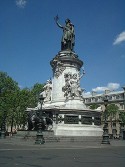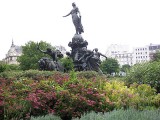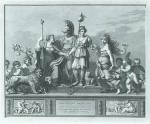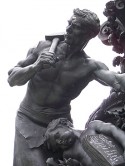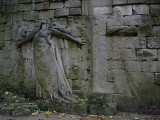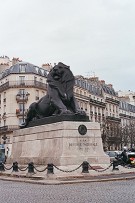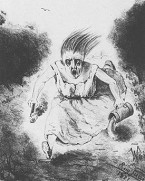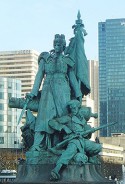The browser will either open the file, download it, or display a dialog.
Environment of Memory: Paris and Post-Commune Angst
In 1871, Karl Marx asked, "What is the Commune, that sphinx so tantalizing to the bourgeois mind?"[1] Straightforward as the question may have seemed, there was no satisfactory answer.[2] The three-month spring uprising following the Prussian siege of Paris had emanated from a series of political tensions that included an evolving national identity, religious turmoil, bourgeois excess, proletarian unrest, and shifting gender roles. Though the revolt was primarily carried out by the working classes, the Commune's ramifications threatened all strata of Parisian society and permeated the entirety of the fin-de-siècle memorial landscape.
The government tried to hide obvious physical markers of the revolt beneath an intensive program of Republican monument building. However, the new monuments provided only a façade of a city untroubled by its recent past. Beneath the official rhetoric, vestiges of the Commune manifested themselves acutely in the city's memorial spaces, and filled the urban sphere with competing understandings of the revolt. Accordingly, no universal memory developed and the Commune could not be historicized into a finished event of the past.[3] With the Commune remaining alive in a state of an "eternal present," a continuous and self-perpetuating discourse of conflicting memories flowed throughout the urban landscape.[4] The irresolvable nature of this exchange among Parisian sites of memory trapped the Republican audience in an angst-ridden stasis—unable to escape the past while desperately seeking its image for the future.
Scholars such as Maurice Agulhon, June Hargrove and Jacques Lanfranchi have long noted that the last quarter of the nineteenth century was a golden age of monument building.[5] The Ministry of Public Instruction, which was in charge of the fine arts under the Third Republic, authorized multiple monuments to the Republic and to the National Defense of 1870–71, as well as over 150 monuments dedicated to individuals.[6] This "statuemania" was one example of the Third Republic's effort at self-definition following the 1870–71 crises of the Franco-Prussian War and the Paris Commune.[7] Both the monarchist politicians of the Republic of Moral Order (1873–79) and the conservative bourgeoisie that had a virtual hegemony over the culture of the last twenty years of the century used the capital city as a forum for "appropriate" sculptural images that reflected the values of modern France.[8] As monuments to the Commune would have been antagonistic to the Republic's message, the government's sculptural program did not explicitly address the revolt.
By strictly censoring the public works that it commissioned, the Third Republic hoped to mitigate the potentially subversive impact of the revolt. Through this effort, the government tried to restore the sense of political order and historic continuity that the Commune had aimed specifically to destabilize in acts like the destruction of the Vendôme Column.[9] In demolishing the column, Communards had sought to obliterate the history that the monument condensed and to create a blank slate on which to build a completely new French social structure.[10] For the early Third Republic government, therefore, re-erecting the Column—distasteful as the imperial symbol was—was a necessary step in restoring national order. By negating the Communard iconoclasm, it reclaimed dominion over the historically significant space that the Column occupied and restored the continuity between past and present.[11]
The government's transparent program of minimizing an official Commune memory did not succeed in imposing a form of Commune amnesia. For the most part, the late nineteenth-century audience had lived the Commune experience—including the fall of the Vendôme Column—and, as Eric Hobsbawm suggests, continued to traverse the "river of blood" that divided society.[12] Janice Best has argued that public monuments like Léopold and Charles Morice's La République (fig. 1) and Jules Dalou's The Triumph of the Republic (fig. 2), both designed for an 1879 Municipal Council competition, were Republican monuments in which the Commune remained present even in its absence.[13] These examples, and others to be discussed below, demonstrate a pattern akin to Derridean slips—a process through which an "absent" or negated understanding of a symbol becomes activated in the affirmed meaning.[14]
Often, it was the location of monuments—or in some instances buildings—that helped trigger memories of the Commune. With the church of Sacré Coeur on Montmartre, officials acknowledged that they intended to cover up the physical reminders of the revolt with the new building.[15] Marking the laying of the basilica's foundation stone, architect Charles Rohault de Fleury declared that Sacré Coeur reclaimed for the nation "the place chosen by Satan and where was accomplished the first act of that horrible Saturnalia..."—a reference to the violent beginning of the revolt: the March 18, 1871 executions of Generals Thomas and Lecomte on Montmartre. Rohault de Fleury continued, describing Sacré Coeur as "a cradle where [Communards] thought to dig a grave."[16]
Most monument inauguration speeches did not contain the bombastic rhetoric of Rohault de Fleury's talk. Louis Oustry, the 1882–83 Prefect of the Seine, offered a more typical example in his remarks celebrating the installation of Léopold and Charles Morice's République on July 14, 1883. In his address, Oustry celebrated the tradition of French liberty, and in a thinly veiled reference to Communards' destruction of Paris, he suggested that the time for tearing down had passed. The inauguration of the monument, he proclaimed, marked a new era during which the French would rebuild and perfect the structures of republicanism.[17]
Rather than simply celebrating French liberty and republicanism, the Morices' monument, like Sacré Coeur, operated as part of the government's effort to reclaim contested spaces of the capital. The Municipal Council commissioned the Morices' ensemble for Place du Château d'Eau, a square that had been a major Communard stronghold during the semaine sanglante (bloody week) and was still home to a large proletarian community.[18] Along with installing the statue, the government changed the name of the space to the Place de la République.
To configure a national image of social cohesion, civic calm, and Commune amnesia, the Municipal Council mandated that sculptors like the Morices cull their iconographic programs from the republican rhetoric of the past.[19] Though there are brief acknowledgements of the fin-de-siècle era on two of the twelve small relief panels—panels that narrate a version of the nation's history—the Morices' ensemble conspicuously ignores the 1871 revolt and its ancestors, the Revolution of 1848 and the original Paris Commune of 1789–95.[20] Instead, the visual program makes reference to Enlightenment notions of civic virtue and social cohesion that were at the origin of the 1789 Revolution and became central to Republican propaganda under the conservative Third Republic.[21]
The crowning figure of the monument is a static representation of the Republic holding an olive branch and leaning on fasces. The figure itself—like eighteenth-century precedents including the 1792 colossal figure of Liberty installed at the Place de la Révolution (now Place de la Concorde)—is an idealized, mature woman, in antique costume, with an a-sensual affect. As Margaret Iversen points out, Jean-Jacques Rousseau and his contemporaries had deemed this type of representation appropriate for a republic because the image could simultaneously command the people's respect, inspire noble acts for the public good, and cultivate social cohesion.[22] These concerns still weighed heavily on the Ministry of Public Instruction in the Third Republic. Around the drum of their monument, the Morices placed allegorical figures representing Liberty, Equality, and Fraternity. Carved in a classicizing manner, these sculptures too recall earlier models from the late eighteenth century include the figures of The Republic and Liberty (fig. 3) from Pierre-Paul Prud'hon's 1792 The French Constitution. Such a reliance on century-old allegorical and formal tropes is consistent with other statues of the Republic installed during the same period, including Auguste Clésinger's rigid, Athena-like representation of La République from the Universal Exposition of 1878.[23]
It is difficult to imagine that government officials believed that by simply changing street signs and installing conservative monuments they could erase site-specific Commune memory. It seems more likely that the government was concerned with symbolically controlling the physical space, and dictating the history presented therein. As James E. Young writes, the goal of public monuments is not to deny the possibility for divergent memories. Instead, a public monument produces a shared space into which disparate ideas may be channeled and an "illusion of common memory" can subsequently be fostered.[24] The state may then didactically use the illusion to promote its desired message.[25]
Young's writing about public monuments is rooted in Pierre Nora's theory of sites of memory. In fusing his ideas with those of Nora, Young suggests that monuments can take the pressure to remember away from individuals. Without this burden, people may look towards the future, returning to the past only through sites.[26] For Nora, the emptying of active memory into sites of memory releases individuals from the psychologically and temporally confining environments of real memory. Memory may then function in a manner akin to history—as a representation of a completed event.[27] This has important political implications: for a community no longer held back by the past, a future becomes possible.
In isolation at Place de la République, the Morices' group operates as site of memory. The formal qualities of the sculpture and the narrative of the relief panels suggest an almost seamless transition between republican governments. It thereby mitigates the impact of the 1871 civil uprising while promoting a future unburdened by the recent past. However, the monument landscape of Paris is not a collection of individual sites that function solely in their own sculptural spaces. Instead, it is a network of interconnected monuments and buildings that, in their architectonic conversation, communally inform the memorial spheres of the capital and the nation.
As many scholars have noted, the Morices' monument at Place de la République cannot be discussed without reference to Jules Dalou's Triumph of the Republic at Place de la Nation. The two monuments—both commissioned for the express purpose of celebrating social harmony in the Third Republic—converse from the two ends of the Second Empire Boulevard Voltaire—a major thoroughfare for the city's fin-de-siècle proletarian community. Though critics almost universally praised Dalou's entry into the Municipal Council competition that begot the Morices' République, judges did not deem Triumph of the Republic appropriate for the Place du Château d'Eau.[28] Instead, the city bought the model and later erected a large-scale bronze version at the Place du Trône, another square in the center of a proletarian neighborhood with a history of urban uprisings. It subsequently renamed the installation site Place de la Nation.
Unlike the Morices' ensemble that is so heavily indebted to the artistic traditions of the late-eighteenth and early-nineteenth centuries, Dalou's group fuses figures and motifs from the ancien régime's grand siècle through the artist's own moment. The central grouping of two lions pulling an ornately decorated chariot imbues the monument with the grandeur of France's Baroque past, while maintaining a modern energy appropriate to the early decades of the Third Republic. The Genius of Liberty, with his idealized male body, guides the group's path from his position on the back of the lions. The sculptor positioned allegories of Justice and Labor (fig. 4) pushing the chariot from its sides. In the rear of the ensemble, Dalou included an exuberant female nude—the figure identifiable as both Peace and Abundance—distributing flowers in the wake of the group.[29] The formal and allegorical programs culminate in an elevated Marianne, who calmly strides forward on top of a celestial orb that rests in the chariot's seat. Unlike the Morices' stolid version, Dalou's figure brims with controlled movement and corporeal expressiveness; her gown clings to her body and exposes her sensual curves. At the same time, her position atop the globe, her confident stride, and her distant gaze affirm the Republic's virtue. Remaining chaste and determined while sensually enlivened, she represents a modern, forward-moving republic.
The unidealized figures of Justice and Labor suggest an innovative Republican program based on the socialist-republican rhetoric of 1848 and 1871.[30] Pierre-Joseph Proudhon's mid-century writings, which were central texts for both revolts, held that a republican justice was rooted in social equality.[31] Dalou underscored visually Proudhon's argument by assigning the figure of Justice an attribute of equality—an equilateral triangle and plumb line—suggesting that equality is constitutive to the modern Justice that Dalou represented.[32]
The image of Labor as a guiding force for the Republic is perhaps the most striking aspect of the monument. As John Hunisak notes, with this monument Dalou became the first French artist to depict the urban worker unsentimentally in sculpture.[33] Dalou broke from previously sculpted representations of laborers like Eugène Guillaume's 1849 Reaper or Henri Chapu's 1865 Sower, both of which showcased provincial romanticism, anatomical perfection, and high finishes. Instead, the heavy surface modeling that Dalou used to create the bulges of muscle and flesh on the worker's back, as well as the work-worn face, emphasize formally the reality of the urban laborer's condition.[34]
By including the figure as a guide for the chariot's path, Dalou elevates physical labor to an agent fundamental for the nation's progress in modernity. This declaration of the worker's essential position in the Republic reflects the view that many Communards held about the proletariat's place in society. Throughout the uprising Communards referred to each other as "Worker," not as "Citizen"—the traditional form of Republican address from the 1789 Revolution.[35] The change in title reflects a new vision of society in which a respect for labor weighed more than an imprecise notion of citizenship that perpetuated a society divided by codified social tiers.[36]
The Republic that Dalou modeled specifically recalled Commune politics and therefore posed problems for a government that sought to eliminate urban references to the revolt. When they first inaugurated the group in 1889, Third Republic leaders were careful to keep the ceremony from evolving into a celebration of the worker or of socialist-republican principals.[37] A military parade and speeches by conservative politicians enfolded the monument into standard Third Republic propaganda in line with works like the Morices' ensemble.[38]
At Père Lachaise cemetery, which is connected directly to both Place de la Nation and Place de la République by Second Empire boulevards, a third distinct site of Commune memory further complicated the late-nineteenth-century memorial sphere. Beginning in the early 1880s, the government allowed anti-government radicals to demonstrate at the cemetery and its Mur des Fédérés (Wall of the Federals)—a space widely acknowledged as the last bastion of Commune resistance during the bloody week.[39] By allowing radicals to co-opt this space, the government fostered a memory of the Commune as the trace of something bloody, fanatical, and ultimately failed—a memory that was no threat to conservative governance, social cohesion, or national unity.[40] As Bertrand Tillier contends, because of the memory transmitted through the Wall of the Federals, the Commune was no longer honored for the hope and promise of its beginnings, but instead it became synonymous with its crushing defeat.[41]
Like the government, radicals had a stake in preserving this site of Commune memory—not as a site of failed rebellion but as a place of martyrdom. Even in 1907, when the Parisian municipal council bought Paul Vautier-Moreau's Monument to the Victims of Revolutions (fig. 5) intending to place it inside Père Lachaise in order to finally bring the Commune into the French narrative of nineteenth-century revolutions, radicals insisted that the municipal government install the memorial, which Vautier-Moreau sculpted from the stones of a former Communard barricade and on which he engraved Victor Hugo's call for an end to vengeance, outside the walls of the cemetery.[42] Keeping the monument and its message of reconciliation removed from the actual space of execution allowed radicals to maintain the Mur de Fédérés as a site of tension.[43]
In her discussion of the Third Republic's urban program, Janice Best maintains that the narrative and formal qualities manifest in monuments and memorial spaces contained "the very traces of the era's debates about efforts to commemorate or eradicate the memory of the Commune."[44] More specifically, the new monuments and memorial spaces of late nineteenth-century Paris engaged the culturally debilitating question about the primary character of the revolt itself. For example, in the 1 1/4 kilometer area bounded by Père Lachaise, Place de la Nation, and Place de la République, there are three distinct sites of Commune memory that historicize four different Commune memories: the Morices' concealment of the revolt; Dalou's celebration of the socialist-republican values that many Communards espoused; and the doubly coded Père Lachaise, where the government contended that bloodthirsty extremists propagated the vile revolt and radicals venerated fallen Communards as slain martyrs. Because the fractured messages in the memorial spaces maintained Paris in a state of eternal present, to live in this space was to constantly face existential questions that the Commune had prompted about national identity.
Because the discourse between Parisian sites of Commune memory dominated the urban structure of the city, it drew other monuments, which seem merely tangential to the Parisian uprising, fully into the web of Commune memory. June Hargrove and Michael Dorsch have argued that the government erected a series of Franco-Prussian War memorials that addressed their own set of concerns unrelated to the Commune insurrection.[45] However, when monuments like Frédéric-Auguste Bartholdi's Lion of Belfort or Louis-Ernest Barrias's The Defense of Paris became part of the urban fabric, they too became burdened with Commune memories.
Carved into an Alsatian mountain between 1872 and 1879, Bartholdi's Lion of Belfort symbolized the glorious French defense of the Alsatian city during the Franco-Prussian War. When the Municipal Council commissioned Bartholdi to make a copper version for Paris (inaugurated September 21, 1880), its installation at the center of Place Denfert-Rochereau (fig. 6) complicated the intended message of national resistance. Because Place Denfert-Rochereau adjoins the Butte aux Cailles—a neighborhood in which the Communards had repeatedly repulsed the Versailles army—the space invests the work with a reminder of the nation's recent fratricide.[46] Given the memorial structure of Paris, the pedestal inscription "A La Défense Nationale: 1870-1871" marries the Prussian siege to the secessionist Commune as dual threats to the nation. However, the implicit reminder of the violence that the government carried out against Parisians tempers a wholesale glorification of the state and corresponding damnation of the capital.
To justify these atrocities committed by the troops from Versailles, the bourgeoisie often evoked the pétroleuses—female supporters of the Commune who allegedly set fires throughout Paris during the last days of the revolt. Stereotype images show the pétroleuse as a wild-haired hysteric, menacing Paris with her torch and gasoline (fig. 7). These representations of Parisian women affirmed—for bourgeois audiences—the vile and lawless character of the Communards. Moreover, they implied that the government's harsh intervention against the rebels was necessary for the safety of the nation—both physically and morally.[47] In the years after the Commune, conservatives exploited these images to legitimize their bourgeois claims that women of the Paris—especially those who existed outside of the domestic sphere—were unnatural, uncontrolled, anti-order and, as a result, sexually-depraved.[48]
This discourse about the nature of Parisian women brought the Commune to bear on Louis-Ernest Barrias's Franco-Prussian War memorial The Defense of Paris 1870-1871 (fig. 8). The sculptor modeled a curvaceous modern woman of the capital protecting a fallen national guardsman and pitiable young girl. Barrias denies the viewer sensual access to his figure of Paris through the rigidity of the fabric that covers her torso. The pronounced closure of the jacket, which the sculptor achieves through the emphasis on her buttons and in contrast to the open flap of the guardsman's jacket, creates a sense of a chastity breastplate; she is a far cry from the stereotyped pétroleuse. While Dorsch argues that Barrias's group plays on male anxieties following the French defeat to the Prussians during the année terrible, within the post-Commune environment of Paris, the work equally engages the polemics of evolving gender roles—an issue that rose in the nation's consciousness during the revolt.[49] Here, outside of the domestic sphere, but within the embrace of the guard's uniform, Paris and her women are again models of the Republic.
In the decades following the Commune, the French government used public monuments such as Barrias's in an effort to connect the legacies of a noble past and examples of military fortitude with the expected grandeur of the future. However, the campaign was in vain because memories of the Commune, which the Third Republic tried to eliminate from the memorial sphere, permeated the landscape and disrupted the new Republic's narrative.[50] The effort to force a Commune amnesia did not take the nature of the revolt into account. Though Frenchmen could date the Paris Commune to the spring of 1871, the social tensions that led to the Commune could not be temporally bound; they existed before the assassinations of Generals Thomas and LeComte and did not die at the barricades during the bloody week. Blurring the spaces and events of the three-month uprising neither dissipated the underlying conflicts that had caused it, nor sutured the wounds that the fratricide had inflicted onto the social fabric of the nation.
In his writings on historical time, Reinhart Koselleck asserts that historical continuity is dependent on the "space of experience" being a reasonable predictor for the "horizon of expectations."[51] When lessons from the past seem remote from future possibilities, the present becomes unpredictable and a condition of cultural angst develops. Such was the case in the early Third Republic, and this angst manifested itself in the monument sphere. Because the divergent memories of the Commune so muddled the literal space of experience, the monuments that the government erected reflected a type of urban anxiety. They were forbidden from directly confronting the recent past and, therefore, the future of national glory and social cohesion that they predicted seemed quixotic. Accordingly, Third Republic monuments evoked Commune memories that continuously rebounded against each other while remaining detached from a broader historical narrative. This prevented a universal Parisian history from developing, and thus made the urban landscape a tortured environment of memory in an eternal present
As Edward Soja wrote, urban space is not simply a "container" in which society functions, but it is a "structure created by society."[52] The discourse of memories among Third Republic memorial sites exposes both the dynamics of the government's efforts to force a Commune amnesia and also a broader condition of internal conflict for Frenchmen in the fin de siècle. In the capital's monumentscape that subversively manifested the national ambivalence about the Commune, the tormented national consciousness gained a voice. This environment retarded the Republic's ambitious urban program as French society struggled to carve a new model of national identity from the imprisoning stone of the Commune's past.
I wish to thank the Dahesh Museum for its generous publication support.
This project has benefited from Professor June Hargrove's tireless attention and her encouragement. Thanks are also due to Professor Petra Chu for her insightful editorial comments as well as to Professors Patricia Mainardi, Brian Lukacher, Stephen Edidin, Anne Higonnet and the participants of the Sixth Annual Graduate Student Symposium at the City University of New York. Finally, I am grateful to Professor James Hargrove for his remarks on this article as it evolved. Unless otherwise noted, all translations are my own.
[1] Karl Marx, The Paris Commune, trans. Lucien Sanial (New York: New York Labor Company News, 1920), 70.
[2] For the conservative bourgeoisie, Paris's revolt marked the capital's descent into animalistic savagery. Republican-socialists shared a different view, often remembering the Commune with political idealism. Still others, like Victor Hugo, chose not to remember the Commune as either all good or all bad. Hugo believed in the Republican principles that he saw at the center of the movement, but questioned whether the revolt's leaders were the right men to lead it. For more, see Peter Starr, Commemorating Trauma: The Paris Commune and its Cultural Aftermath (New York: Fordham University Press, 2006).
[3] For a distinction between memory and history, see Pierre Nora, "Between Memory and History: Les Lieux de Mémoire," in "Memory and Counter-Memory,"special issue, Representations 26 (Spring,1989): 7–24. Nora writes, "Memory and history, far from being synonymous, appear now to be in fundamental opposition," 8.
[4] For an explanation of the conditions that produce an "eternal present," see ibid., 8.
[5] See Maurice Agulhon, Marianne au combat: L'imagerie et la symbolique républicaines de 1789 à 1880 (Paris: Flammarion, 1979); Maurice Agulhon, Marianne au pouvoir: L'imagerie et la symbolique républicaines de 1880 à 1914 (Paris: Flammarion, 1989); June Hargrove, The Statues of Paris: An Open-Air Pantheon (New York; Paris: Vendôme Press, 1990); Jacques Lanfranchi, Les statues des grands hommes à Paris: Cœurs de bronze, têtes de pierre (Paris: L'Harmattan, 2004).
[6] Hargrove, Statues of Paris, 105.
[7] Though the Franco-Prussian War and the Commune share a temporal moment and their events are intricately related, the philosophical roots at their origins differ. As Robert Gildea suggests, the seeds of the 1870–71 Franco-Prussian War originated in the Imperial Wars of Napoleon I, and the antagonist Franco-Prussian relationship of the nineteenth century. By the latter part of the century, German nationalism and French pride came into conflict as the Prussian state exerted more authority in European affairs while France's Second Empire was slipping from its position at the head of the continent. The Commune, on the other hand, emerged from the ashes of the workers' Revolution of 1848 and the growing internationalist workers' movement of the 1860s. See Robert Gildea, The Children of the Revolution: The French, 1799–1914 (Cambridge, MA: Harvard University Press, 2008).
[8] See Hargrove, Statues of Paris, 105–261.
[9] See Kristin Ross's discussion of the toppling of the Vendôme Column in The Emergence of Social Space: Rimbaud and the Paris Commune (Minneapolis: University of Minnesota Press, 1988), 6–9.
[10] As Ross contends, many Communards hoped that in the new structure the worker and the craftsman would find a place in the literal center of Parisian society, removed both physically and politically from the Haussmann-defined city margins. Ibid., 41–42.
[11] See Kevin Charles Smith, "Bare Pedestals: The Text of Public Monuments in Nineteenth-Century Paris" (PhD. diss., Princeton University, 1996), 100–186. As Smith has explained, from the Ancien Régime through the Third Republic, Place Vendôme was a theatre for "politics of symbolic power." The Commune's attack on the Column was another act in a century-long drama where governments and rebels altered the monument to didactically suggest their relationships to French history.
[12] Eric Hobsbawm, The Age of Capital: 1848–1875 (New York: Vintage Books, 1975), 169.
[13] Janice Best, "Une Statue monumentale de la République," Nineteenth Century French Studies 34, nos. 3/ 4 (Spring/Summer 2006): 303–22. Colette Wilson has made a similar case for the absent presence of the Commune during the 1878 World's Fair and in the popular literature and journals of the 1870s. See Colette Wilson, "Memory and the Politics of Forgetting: Paris, the Commune and the 1878 Exposition Universelle," Journal of European Studies 35, no. 1 (2005): 173–89; and Colette Wilson Paris and the Commune, 1871–1878 (Manchester: Manchester University Press, 2007.)
[14] I owe a special thank you to my fellow University of Maryland graduate student Steven Cody for pointing me in the direction of Derrida in my discussion of presence and absence. See Jacques Derrida, "Différance," in Margins of Philosophy, trans. Alan Bass (Chicago: University of Chicago Press, 1982), 3–27.
[15] David Harvey, "Monument and Myth," Annals of the Association of American Geographers 69, no. 3 (September, 1979): 362–81.
[16] Quoted ibid., 370.
[17]L'Evénement July 16, 1883, quoted in Janice Best, "Statue monumentale," 311.
[18] For the Morices' victory in the competition for a monument at Place de la République see Rapport: Annexe au proces-verbal de la séance du 22 juin 1880. Archives de Paris, 139932. See also Maurice Agulhon's discussion of the square, its changing names, and its working-class population in Maurice Agulhon, "Paris, A Traversal from East to West," in Realms of Memory: The Construction of the French Past, under the direction of Pierre Nora, ed. Lawrence D. Kritzman, trans. Arthur Goldhammer (New York: Columbia University Press, 1998), 539–40. For a discussion of Place du Chateau d'Eau during the bloody week, see Thomas March, The History of the Paris Commune of 1871 (London: Swan, Sonnenschein, and Company, 1896), 316–17. In March's words, the last week of the Commune (the Bloody Week), when the Versailles troops increased their assault on the city in order to break the Commune, saw "Deaths, wounds, and human carnage generally, alas were but every day and almost every hour occurrences in the most bloody week!" 317.
[19] The Municipal Council's guidelines for the competition mandated a design that would visually separate the new Republic from the radical Commune. The Council asked sculptors to create a "traditional" image of the Republic, mounted on a pedestal and surrounded by allegorical figures. Contemporary Parisians derided the charge, which critics believed would inhibit artists from any formal or thematic innovations. In October, 1789, Stéphane Loysel wrote in L'Illustration that the majority of the models were marked by an "absolute lack of originality." See Daniel Imbert, "Le Concours de 1879: Remarques sur quelques projets présentés,"in Quand Paris Dansait avec Marianne 1879-1889, exh. cat. (Paris: Editions Paris Musées, 1989).
[20] Jean Constanciel explored the connections between the Paris Commune of the 1790s and that of 1871 in a proposal for a monument to the Commune through a linking of Jean-Paul Marat with the "martyrs" of 1871. For a discussion of the Morices' conspicuous avoidance of the Revolution of 1848 in their monument, see Best's discussion of the relief panels around the drum. Best, "Statue monumentale," 311.
[21] For instance, when establishing a national holiday in 1880, the National Assembly specifically chose to commemorate the July 14, 1790 fête de la Féderation in place of the July 14, 1789 attack on the Bastille because of the democratic principles that it symbolized. See James Patrick Daughton, An Empire Divided: Religion, Republicanism and the Making of French Colonialism, 1880–1914 (Oxford: Oxford University Press, 2006), 102.
[22] Margaret Iversen, "Imaging the Republic: The Sign and Sexual Politics in France," in The Enlightenment and its Shadows, ed. Peter Hulme and L.J. Jordanova (London: Routledge, 1990), 130–32.
[23] Given the Third Republic's interest in former models of Republicanism, perhaps it is not surprising that in 1880 the government transferred Jean-François Soitoux's winning sculpture from the 1848 competition for an official image of the Second Republic from the caverns of the Empire's storage rooms to a spot in front of the Institut de France.
[24] James Young, The Texture of Memory: Holocaust Memorials and Meanings (New Haven and London: Yale University Press, 1993), 6.
[25] That appears to be precisely what the French government had in mind when it commissioned The 14th of July, 1880 from the artist Alfred Roll in 1880. In this official painting, exhibited at the Salon of 1882, Roll depicts a scene of class interaction during a fête populaire. The Morices' monument, which the state had yet to inaugurate, figures prominently in the background of the scene. Among the crowd gathered in the foreground, the painter includes representatives from all strata of Parisian society in a harmonious celebration of the nineteenth century's first fête nationale. Like the 1880 holiday itself, Roll's image and the Morices' "traditional" monument suggest that the urban spaces of Paris were witness to a largely unbroken and peaceful history of nineteenth-century Republicanism.
[26] Young, Texture of Memory, 5.
[27] Nora, "Between Memory and History," 8. Nora argues that in the absence of milieux de mémoire (environments of memory), sites of memory develop. These sites, he writes, are the places where memory, "crystallizes and secretes itself." The exchange of milieux for sites marks a cultural break with the past that stems from man's inability to "live within memory."
[28]Rapport: Annexe au proces-verbal de la séance du 22 juin 1880.
[29] Dalou adorned the figure with attributes of both Peace (an olive branch) and Abundance (a cornucopia) and thereby seems to have brought the two allegories together in one figure. As it is the only large-scale figure that does not guide—psychologically or physically—the chariot, but instead trails the group, it is likely that Dalou meant to suggest that peace and abundance would be the products of a rightly guided France.
[30] Best suggests that the Genius of Liberty should be included with Justice and Liberty as figures that are ideologically aligned with the working class. Best, "Statue monumentale," 313.
[31] K. Steven Vincent, Pierre-Joseph Proudhon and the Rise of French Republican Socialism (New York and Oxford: Oxford University Press, 1984), 64. Proudhon's contention would have been familiar to Dalou, who mounted the Parisian barricades as a ten year-old during the Revolution of 1848 and who was an avid reader of socialist-republican writers including Proudhon and the labor-centric poet Pierre Dupont. Henriette Cailaux, Dalou: L'homme, l'oeuvre (Paris: Librarie Delagrave, 1935), 10–11.
[32] This use of a symbol of equality—rather than weapon—as an attribute of Justice is unique in Dalou's oeuvre. In the artist's Fraternity of 1883, John Hunisak identifies a figure of Justice with a mace. John Hunisak, The Sculptor Jules Dalou: Studies in His Style and Imagery (New York and London: Garland Publishing, 1977), 170. In the sculptor's 1908 monument to Senator Auguste Scheurer-Kestner, one of the senators largely responsible for securing full amnesty for the Communards in 1880, a figure representing Justice holds the sword. Thus, the traditional attributes of Justice were within Dalou's post-exile sculptural vocabulary. The break from the traditional representation of Justice on Triumph of the Republic suggests that the artist intended to express a slightly modified message. Moreover, his turn to a Freemason's symbol—the triangle with a plumb line—may also refer to the much remarked solidarity between Freemasons and Communards during the last weeks of the 1871 uprising. (Special thanks to Professor Chu who reminded me of the freemason origin of the triangle symbol.)
[33] Hunisak, Sculptor Jules Dalou, 221.
[34] Like his contemporaries Auguste Rodin and Emile Zola, Dalou saw himself as an artisan-ouvrier (skilled-laborer or craftsman). The Naturalism and the heavily modeled quality of Labor demonstrate the artistic principles that Dalou held to be the most democratic. For more, see Ann Wagner, "Workers and Artists," in Jean-Baptiste Carpeaux: Sculptor of the Second Empire (New Haven: Yale University Press, 1986), 29–63. Dalou suggests his own place among the class of urban workers by filling Labor's satchel with artists' tools.
[35] Rupert Christiansen, Paris-Babylon: The Story of the Paris Commune (New York: Penguin Books, 1994), 296–371. In his chapter on the Commune, Christiansen repeatedly cites Commune posters that addressed fellow Communards as "workers" rather than citoyens.
[36] For a discussion of the origins of Citizenship in Revolutionary France, see Rogers Brubaker, Citizenship and Nationhood in France and Germany (Cambridge: Harvard University Press, 1998), 87. Burbank points out that the first French constitution created multiple levels of citizenship.
[37] In 1889, the government, in the wake of the failed Boulangiste movement, coerced Dalou into exhibiting a plaster version of his monument. The sculptor would have preferred to wait until a bronze cast was complete, but acceded to the wishes of the state. Ten years later, the government inaugurated Dalou's finished bronze in a ceremony that included a parade of laborers. See, Maurice Dreyfous, Dalou: Sa vie et son œuvre (Paris: Librarie Renouard-Henri Laurens, 1903), 138. This monument, and specifically this second inauguration ceremony, is a subject in my ongoing research. I believe the second ceremony, during which the real laborer and the allegorical representation of the laborer were both feted in the name of the Republic, signals that a profound shift was occurring in the relationship between the Third Republic and the memory of the Commune at the turn of the century.
[38] Dalou saw the proceedings as a usurpation of the triumph of labor that he had sought to express sculpturally. Speaking to Jean Tild, Dalou complained, "Where was the army of labor hiding during this old-fashioned gala? Where were my praticiens (practitioners), my ajusteurs (metal-workers), my casters, and my plaster workers? Or the millions of arms which create? or those who labor on soil?" Jean Tild, "Dalou : La Gènese d'une oeuvre," La Renaissance de l'art français et des industries de luxe, April 1920, 180–86, at 182 and as quoted in Hunisak,Sculptor Jules Dalou, 229.
[39] For more on the Mur des Fédérés as a site of memory in the Third Republic, see Madeleine Rebérioux, "Le Mur des Fédérés: Rouge «sang craché»," in Les Lieux de mémoire, ed. Pierre Nora (Paris: Gallimard, 1984), 1:619–49.
[40] Rebérioux points out that many Communards and their sympathizers initially refused the wall's power as a site of memory because of the radical presence. Ibid., 624.
[41] Bertrand Tillier, La Commune de Paris: Révolution sans images? (Paris: Editions Champ Vallon, 2004), 422.
[42] Ibid., 428–29. The engraving reads, "Ce que nous demandons à l'avenir, ce que nous voulons de lui, c'est la justice, ce n'est plus la vengeance," (What we ask of the future, what we want from it, is justice and no longer is it vengeance.)
[43] Ibid., 429–35.
[44] Best, "Statue monumentale," 314.
[45] June Hargrove, "Qui Vive? France! War Monuments from the Defense to the Révanche," in Nationalism and French Visual Culture, ed. June Hargrove and Neil McWilliam (Washington, DC: National Gallery of Art, 2005), 55–81; Michael Dorsch, "Strong Women, Fallen Men: French Commemorative Sculpture Following the Franco-Prussian War, 1870-1880," (PhD diss., Institute of Fine Arts, New York University, 2001).
[46] See March, History of the Paris Commune, 311–12.
[47] For more on the pétroleuses, see Gay Gullickson, The Unruly Women of Paris: Images of the Commune (Ithaca: Cornell University Press, 1996). Gullickson describes the images of the pétroleuses as a "symbolic inversion of Delacroix's Liberty." It is worth noting that counter-images also developed, including the iconic representation of Communarde Louise Michel as the "Red Nun." These images shed a sympathetic light on the rebels' actions. The dueling images of communardes influenced discourses on gender roles in the fin de siècle.
[48] See ibid., 173–80.
[49] Though Dorsch opens his dissertation with a thorough discussion of pétroleuse imagery, in his analysis of Barrias's group at La Défense Dorsch does not pursue the questions of national female identity and the petroleuse that are central to my discussion. Of course, the Commune was not the only factor in making issues about gender roles and women's position within society a focus in fin-de-siècle France.
[50] As Neil McWilliam pointed out in his essay on the Parisian commemorations of Joan of Arc and Etienne Dolet in the late nineteenth-century, "monumental commemoration can occasion expressions of dissent as readily as it generates enthusiastic endorsement." Neil McWilliam, "Conflicting Manifestations: Parisian Commemoration of Joan of Arc and Etienne Dolet in the Early Third Republic," French Historical Studies 27, no. 2 (Spring, 2004): 381–418, at 383.
[51] Reinhart Koselleck, "'Space of Experience' and 'Horizon of Expectations': Two Historical Categories," in Futures Past: On the Semantics of Historical Time, trans. Keith Tribe (New York: Columbia University Press, 2004), 255–75.
[52] Edward W. Soja, "The Socio-Spatial Dialectic," Annals of the Association of American Geographers 70, no. 2 (June, 1980): 207–25, at 210. Emphasis in the original.


